PT Lion Mentari Airlines, operating as Lion Air, is an Indonesian low-cost airline. Based in Jakarta, Lion Air is the country's largest privately run airline, the second largest low-cost airline in Southeast Asia and the largest airline of Indonesia. With Wings Air and Batik Air, Lion Group is the country's largest airline's group. The airline operates domestic as well as international routes, which connects different destinations of Indonesia to Singapore, the Philippines, Malaysia, Thailand, Australia, India, Japan and Saudi Arabia, as well as charter routes to Mainland China, Hong Kong, South Korea and Macau, with more than 630 flights per day.
PT Merpati Nusantara Airlines, operating as Merpati Nusantara Airlines, was an airline in Indonesia based in Central Jakarta, Jakarta. It operated scheduled domestic services to more than 25 destinations in Indonesia, as well as scheduled international services to East Timor and Malaysia. The word merpati is Indonesian for "dove", and Nusantara is a Javanese word found in the Pararaton meaning "the outer islands", referring to the Indonesian archipelago. The airline was based at Soekarno-Hatta International Airport, Jakarta. It also maintained both a maintenance and simulator facility at Juanda International Airport, Surabaya. The Merpati Training Centre at Surabaya housed Fokker F-27, AVIC MA60 and CN-235 full motion simulators.
Sriwijaya Air is an Indonesian airline headquartered and based at Soekarno–Hatta International Airport in Tangerang, Banten. It began its operations on 10 November 2003, and flies scheduled and chartered services on domestic routes within Indonesia as well as international routes to neighbouring countries. The airline's slogan is Your Flying Partner.

AdisutjiptoAirport is an airport serving the Yogyakarta area on the island of Java, Indonesia. It was formerly the principal international airport serving this area. The airport is located in the Sleman Regency, in the Yogyakarta Special Region, on the north-east outskirts of the city, near the Prambanan historic temple site. The airport is approximately 6 kilometres (3.7 mi) from the city centre.
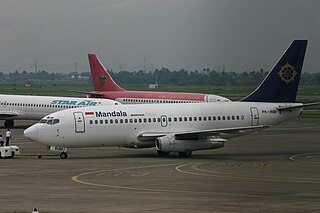
Mandala Airlines Flight 091 (RI091/MDL091) was a scheduled domestic passenger flight from Medan to Jakarta, operated by Mandala Airlines with a Boeing 737-200Adv. On September 5, 2005 at 10:15 a.m. WIB (UTC+7), the aircraft stalled and crashed into a heavily populated residential area seconds after taking off from Polonia International Airport. Of the 117 passengers and crews on board, only 17 survived. An additional 49 civilians on the ground were killed.
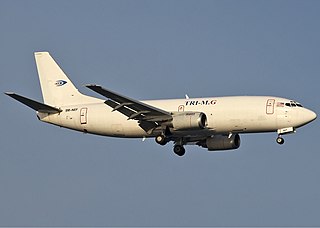
Asia Cargo Airlines is an airline that mainly operates cargo aircraft on scheduled routes for contract charters and non-scheduled routes for ad-hoc charters.

Halim Perdanakusuma International Airport is an international airport in Jakarta, Indonesia. The airport is located in East Jakarta and the airfield is conjoined with the Halim Perdanakusuma air force base of the Indonesian Air Force.

Sultan Hasanuddin International Airport is an international airport in Makassar, South Sulawesi. It is located 20 km (12 mi) northeast of Makassar's city centre and is operated by PT. Angkasa Pura I. The current terminal was opened on 20 August 2008. The airport is the main gateway for flights to the eastern part of Indonesia, and named after Sultan Hasanuddin (1631–1670), a Sultan of Gowa, who fought against the Dutch East India Company in the 1660s.
Trigana Air is an airline based in Jakarta, Indonesia.

PT TransNusa Aviation Mandiri, operating as TransNusa, is an Indonesian low-cost carrier based in Jakarta Soekarno–Hatta International Airport. It was launched in August 2005, serving various destinations from Kupang, Timor, using aircraft chartered from Pelita Air and Trigana Air Service. In August 2011, TransNusa received its own air operator's certificate (AOC) and scheduled commercial airline permit, operating as a regional carrier. The airline relaunched as a low-cost carrier in 2022 after briefly ceasing operations in 2020 as a result of the COVID-19 Pandemic.
PT Batik Air Indonesia, operating as Batik Air, is an Indonesian scheduled airline based at Soekarno Hatta International Airport in Jakarta, Indonesia. The airline was founded in 2012 as the full-service arm of the Lion Air Group and made its maiden flight on 3 May 2013 from Jakarta to Manado and Yogyakarta. The airline is certified as a 3-Star Airline by Skytrax.

Lion Air Flight 904 was a scheduled domestic passenger flight from Husein Sastranegara International Airport in Bandung to Ngurah Rai International Airport in Bali, Indonesia. On April 13, 2013, the Boeing 737-800 operating the flight crashed into water short of the runway while on final approach to land. All 101 passengers and 7 crew on board survived the accident. At 3:10 pm, the aircraft crashed approximately 0.6 nmi (1.1 km) short of the seawall protecting the threshold of Runway 09. The aircraft's fuselage broke into two and 46 people were injured, 4 of them seriously.

Jhonlin Air Transport is a regional airline in Indonesia that focus on serving the areas in South Kalimantan, Indonesia. The maiden flight of the airline began on November 3, 2011. The inaugural flight route starts from Batulicin to Banjarbaru.
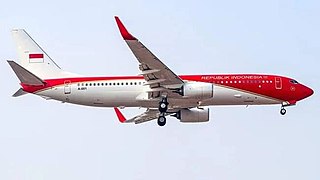
The Indonesian presidential aircraft, also known as Indonesia Air Force Zero One with the serial number A-001 is the presidential aircraft carrying the president and vice president of Indonesia. The aircraft was designed to meet the minimum safety and security standards to support the VVIP air transportation needs of the Indonesian president, and includes a modest self-defense system.

Trigana Air Flight 267 was a scheduled passenger flight from Sentani to Oksibil in the eastern Indonesian province of Papua. On 16 August 2015, the ATR 42 turboprop operating the service crashed on approach in the Bintang highlands region of Oksibil, killing all 49 passengers and 5 crew members.

Sriwijaya Air Flight 062 (SJ062/SJY062) was a scheduled domestic passenger flight, operated by Indonesian airline Sriwijaya Air from Soekarno-Hatta International Airport, Jakarta to Sultan Thaha Airport, Jambi. On 27 August 2008, the aircraft operating the flight, a Boeing 737 series 200 registered as PK-CJG, overran the runway and crashed onto a house during its landing attempt at Jambi. Due to the accident, 26 people were injured, including 3 people on the ground. One person later succumbed to his injuries. Everyone on board the aircraft survived the crash. It was the first fatal crash in Sriwijaya Air's operational history and was the only fatal accident until Sriwijaya Air Flight 182 crashed in 2021.
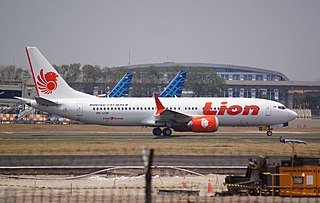
{{OSM Location map | coord = 4.3°S 105.7°E
Jayawijaya Dirgantara is an airline based in Jakarta, Indonesia. It operates domestic / regional cargo flights in the territory of the province of Papua. Its main base is at Halim Perdanakusuma Airport.
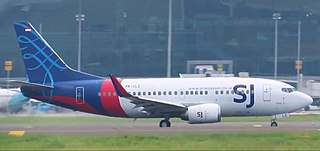
Sriwijaya Air Flight 182 was a scheduled domestic passenger flight from Jakarta to Pontianak, Indonesia. Five minutes after departing from Soekarno–Hatta International Airport on 9 January 2021, the Boeing 737-500 experienced an upset and crashed into the Java Sea off the Thousand Islands, killing all 62 people on board. A search of the area recovered wreckage, human remains, and items of clothing. The flight data recorder (FDR) was recovered on 12 January, and the data storage module of the cockpit voice recorder was recovered on 30 March.
















